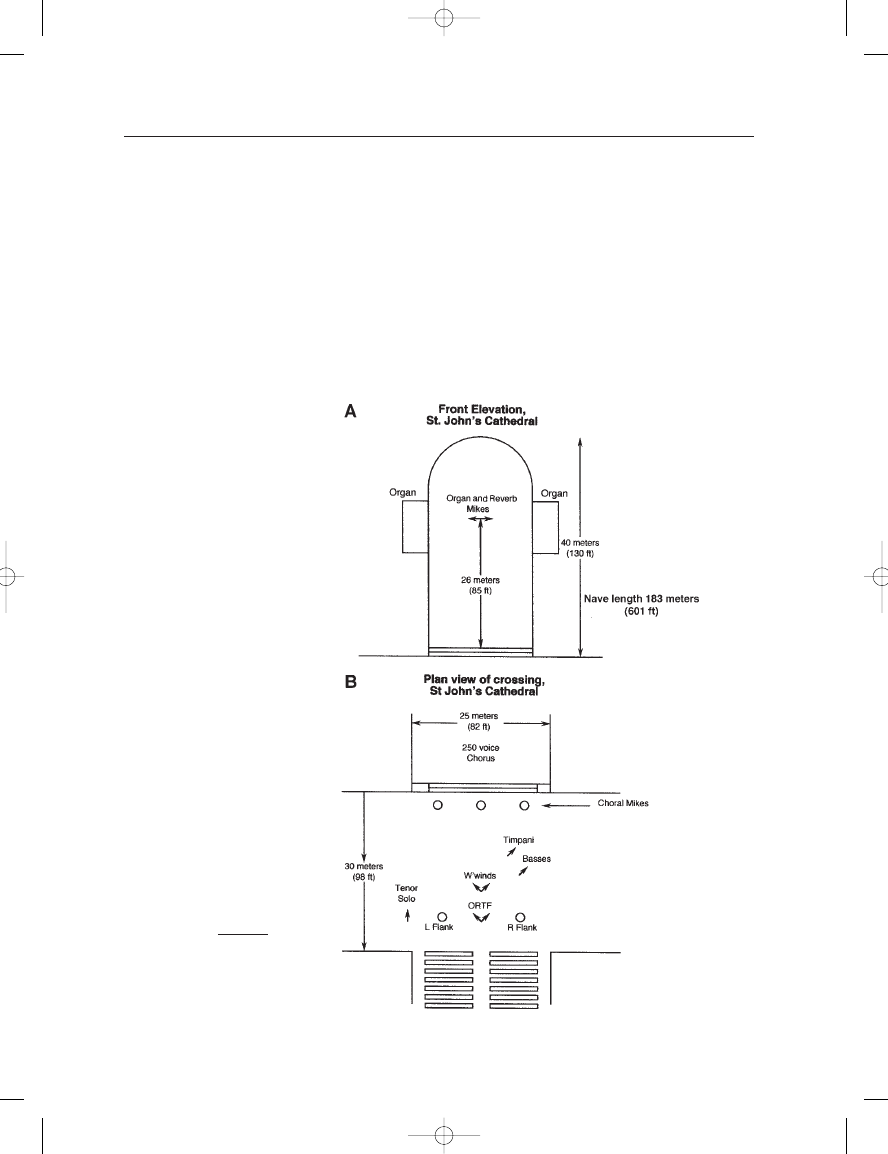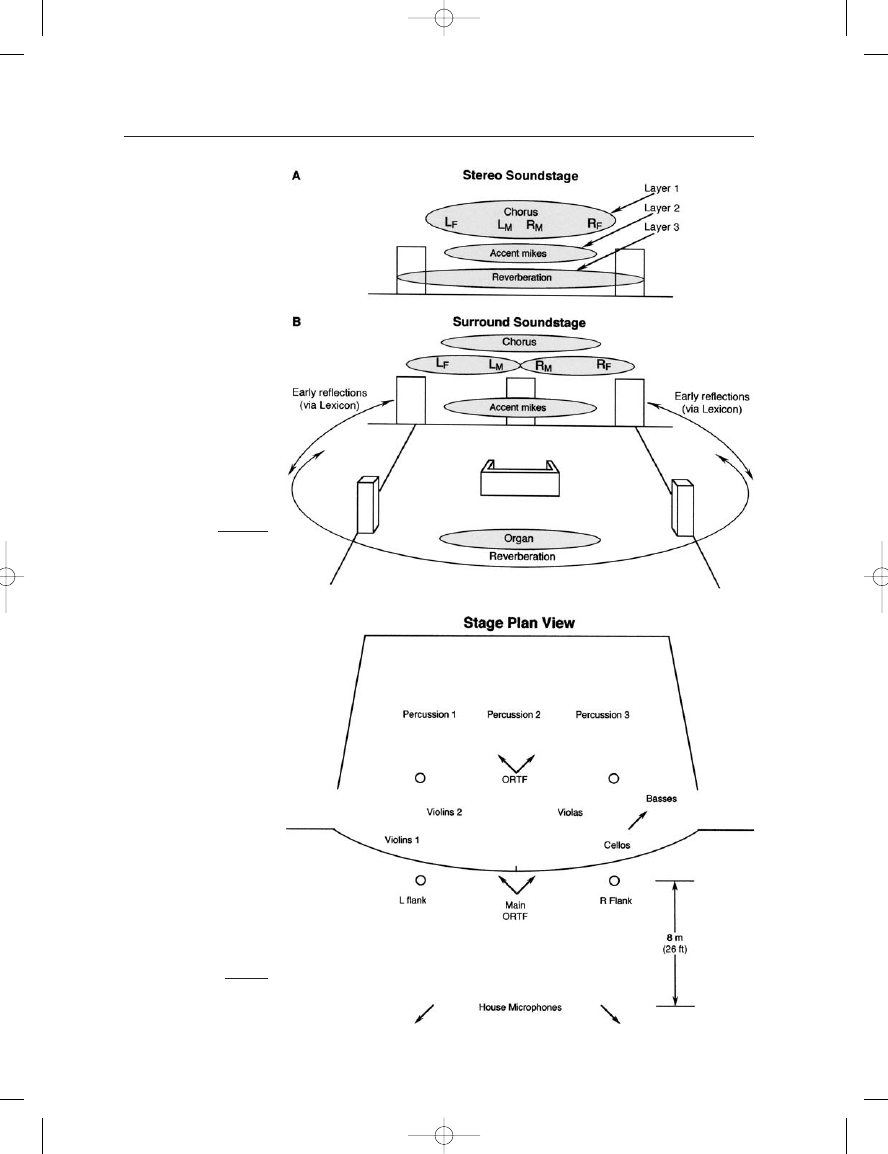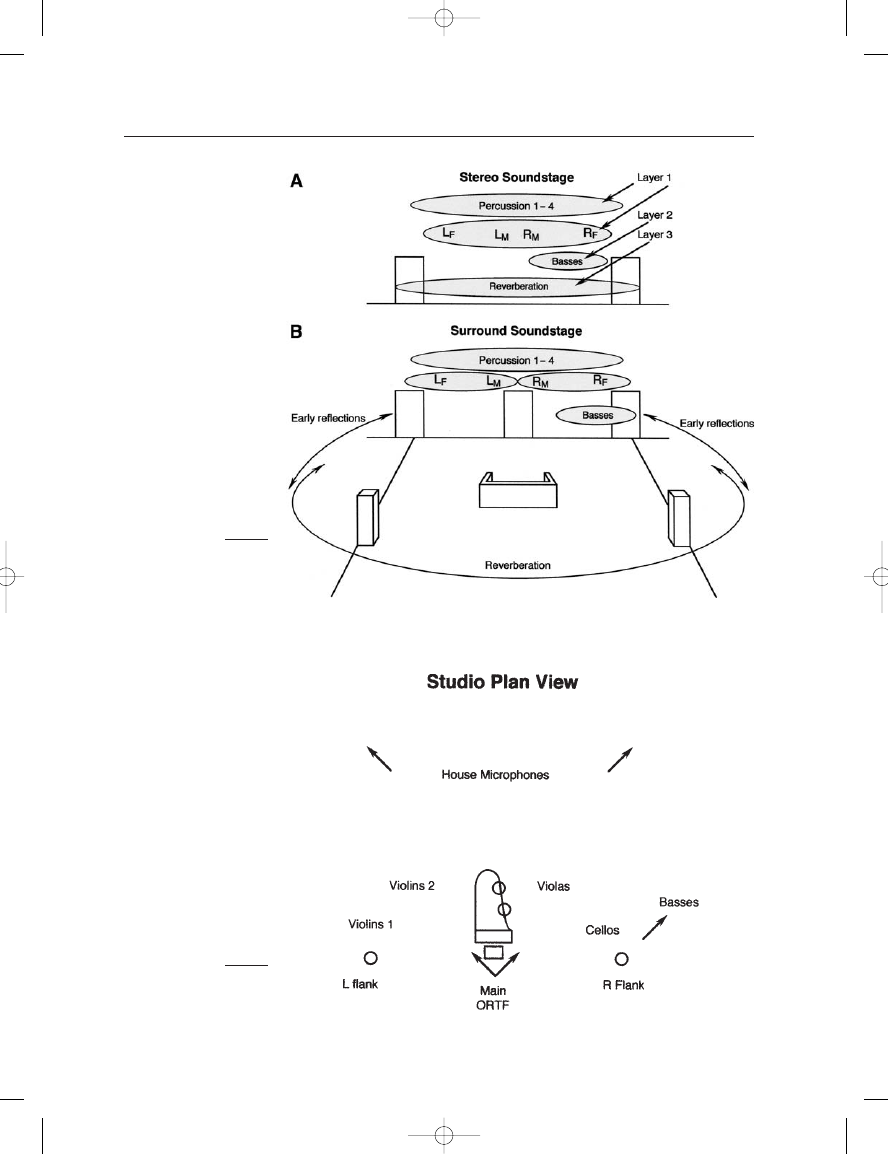ВУЗ: Казахская Национальная Академия Искусств им. Т. Жургенова
Категория: Книга
Дисциплина: Не указана
Добавлен: 03.02.2019
Просмотров: 17267
Скачиваний: 51

As the postproduction of the recording got underway it was apparent
that the chorus sounded “very present and very distant” at the same
time. The obvious solution was to add ambience to the recording using
a program in the Lexicon model 300 reverberation generator. This pro-
gram adds only a set of simulated early reflections and as such gave an
effect of immediacy and naturalness not present in the basic recording.
Another problem we faced was where to put the house microphones.
The audience in the nave numbered 4000, and there was no way to posi-
tion stereo microphones 40 m (130 ft) above them. The solution here
was to position the house microphones 25 m (80 ft) above the chorus
adjacent to the organ pipes. As a result of this, you will hear the organ
16: Surround Recording Case Studies
283
FIGURE 16–8
Stage and microphone
layout for Te Deum:
elevation view (A);
plan view (B).
Earg_16.qxd 14/9/04 2:59 PM Page 283

and reverberant signature of the Cathedral both from the rear channels,
and this is very much the way the work was originally heard in Paris in
1855, where the organ was in the rear gallery.
As with the previous examples, the stereo monitor mix was recorded
on tracks 1 and 2 of the digital recorder. Figure 16–8 shows views of the
recording and microphone setup, and Table 16–5 shows the deployment
of microphones. Figure 16–9 shows the resulting stereo and surround
sound stages.
SELECTIONS FROM CARMEN BALLET BY
BIZET-SHCHEDRIN
The Carmen Ballet is an arrangement of music from the opera Carmen
for strings and large percussion resources. The recording was made by
the Monte Carlo Philharmonic Orchestra, conducted by James DePreist,
24–27 June 1996, in the Salle Garnier in Monte Carlo, Monaco.
Figure 16–10 shows views of stage and microphone layout, and
Table 16–6 shows microphone and track deployment.
The engineer and producer made the decision early on to assign each
of the percussion microphones to a separate track. This provided utmost
flexibility in rebalancing any of the percussion resources as they might
crop up later in postproduction. In a sense, the percussion elements were
THE MICROPHONE BOOK
284
TABLE 16–5
Microphone Deployment for Te Deum
Position
Description
Stereo Stage
height
Track
panning
assignment
Major components
Stereo mix left
Track 1
Stereo mix right
Track 2
L flank
omni
left
3 m (10 ft)
L ORTF
cardioid
left
3 m (10 ft)
R ORTF
cardioid
right
3 m (10 ft)
R flank
omni
right
3 m (10 ft)
L chorus
omni
left
3.5 m (11.5 ft)
Track 3
C chorus
omni
center
3.5 m (11.5 ft)
Tracks 3/4
R chorus
omni
right
3.5 m (11.5 ft)
Track 4
L house and organ
cardioid
left
25 m (83 ft)
Track 5
R house and organ
cardioid
right
25 m (83 ft)
Track 6
Vocal solo
cardioid
center
2 m (80 in)
Tracks 7/8
Accent microphones (these appear only in the stereo mix)
L woodwinds
cardioid
half-left
3 m (10 ft)
R woodwinds
cardioid
half-right
3 m (10 ft)
Basses
cardioid
right
2 m (80 in)
Timpani
cardioid
center
1.5 m (5 ft)
Earg_16.qxd 14/9/04 2:59 PM Page 284

16: Surround Recording Case Studies
285
FIGURE 16–9
Recorded soundstages
for Te Deum: stereo (A);
surround sound (B).
FIGURE 16–10
Stage and microphone
layout in plan view.
Earg_16.qxd 14/9/04 2:59 PM Page 285

an unknown quantity in terms of balance and relative levels, whereas the
string ensemble was, by comparison, very stable and predictable.
Another important decision involving engineer, producer, and con-
ductor was made regarding the relative perspectives of the string ensem-
ble and the percussion ensemble. Physical constraints meant that the
large array of percussion instruments would have to be placed behind
the strings, but musical balance required that the two ensembles be
essentially equal in all respects. In other words, they had to occupy the
same apparent location on the recorded sound stage as the strings rather
than be heard from their natural position behind the strings.
The solution was simple; it was to place an identical set of main
microphones in front of each ensemble, treating them equally in terms of
presence and level. Figure 16–11 shows the resulting sound stages for
both stereo and surround presentation.
CONCERTO FOR PIANO AND STRINGS BY
ALFRED SCHNITTKE
The recording was made on the large scoring stage at Lucasfilm’s
Skywalker Ranch in San Rafael, CA. Constantine Orbelian was both
pianist and conductor of the Moscow Chamber Orchestra. The record-
ing space has dimensions roughly of 27 m (90 ft) by 18.3 m (60 ft) by
9 m (30 ft), and its boundaries can be configured for a variety of acousti-
cal requirements. For this recording the room was set for “moderately
live” acoustics. Figure 16–12 shows details of studio setup and micro-
phone placement. Note that the piano has been placed, with its cover
THE MICROPHONE BOOK
286
TABLE 16–6
Microphone and track deployment for Carmen Ballet
Position
Description
Stereo Mic
height
Track
panning
assignment
Major components
Stereo mix left
Track 1
Stereo mix right
Track 2
Perc. left flank
omni
left
3.5 m (11.5 ft)
Track 3
Perc. left main
cardioid
left
3.5 m (11.5 ft)
Track 4
Perc. right main
cardioid
right
3.5 m (11.5 ft)
Track 5
Perc. right flank
omni
right
3.5 m (11.5 ft)
Track 6
House left
cardioid
left
4 m (13 ft)
Track 7
House right
cardioid
right
4 m (13 ft)
Track 8
Microphones appearing only in the stereo mix
String left flank
omni
left
3.5 m (11.5 ft)
String left main
cardioid
left
3.5 m (11.5 ft)
String right main
cardioid
right
3.5 m (11.5 ft)
String right flank
cardioid
right
3.5 m (11.5 ft)
Basses
cardioid
right
3 m (10 ft)
Earg_16.qxd 14/9/04 2:59 PM Page 286

16: Surround Recording Case Studies
287
FIGURE 16–11
Recorded sound stages for
Carmen Ballet: stereo (A);
surround (B).
FIGURE 16–12
Studio and microphone
layout in plan view.
Earg_16.qxd 14/9/04 2:59 PM Page 287